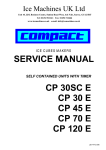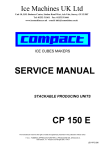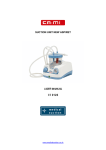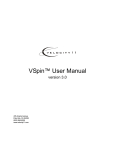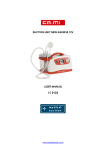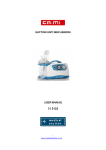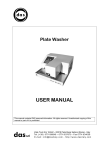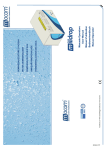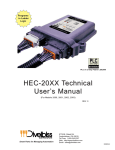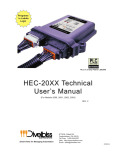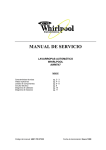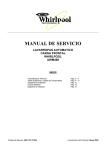Download SERVICE MANUAL CP 22 E
Transcript
Ice Machines UK Ltd Unit 10, LDL Business Centre, Station Road West, Ash Vale, Surrey, GU12 5RT Tel: 01252 511611 Fax: 01252 511666 www.icemachines.co.uk e-mail: [email protected] ICE CUBES MAKERS SERVICE MANUAL SELF CONTAINED UNITS WITHOUT TIMER CP 22 E The manufacturer reserves the right to modify the appliances presented in this publication without notice LEV1FG-296 SELF CONTAINED UNITS WITHOUT TIMER COMPACT SERVICE MANUAL ME-CPN1-199 INDEX 1. 2. 3. 4. 5. HOW IT WORKS 1 1.A. REFRIGERATION SYSTEM 1.A.a. Freezing cycle 1.A.b. Defrost cycle (harvest) 1.A.c. Air cooling 1.A.d. Water cooling 1 2 2 2 2 1.B. WATER SYSTEM 1.B.a. Freezing cycle 1.B.b. Defrost cycle (harvest) 1.B.c. Ice storage bin 4 4 4 4 1.C. ELECTRICAL SYSTEM 1.C.a. Water cooled models 5 6 INSTALLATION 7 2.A. CONNECTIONS 7 2.B. SET-UP 2.B.a. Air cooled condenser units 2.B.b. Water cooled condenser units 7 7 7 START-UP & TEST 8 3.A. WATER FILLING PROCEDURE 8 3.B. START-UP 9 3.C. TEST 9 CLEANING 10 4.A. CONDENSER CLEANING 10 4.B. INTERNAL CLEANING & SANITIZING 4.B.a. Cleaning - To remove lime scale or other mineral deposits 4.B.b. Sanitizing - To remove algae or slime 10 10 12 GENERAL INFORMATION 12 5.A. WEIGHTS & DIMENSIONS 12 5.B. CUBE SIZE 13 5.C. MODEL NUMBER BREAKDOWN 13 5.D. GENERAL DATA 14 5.E. WATER VALVE & FLOW REGULATOR CHART 5.E.a. Air cooled 5.E.b. Water cooled 14 14 14 5.F. PRODUCTION 5.F.a. Theoretical daily ice production - N. of cubes/24h 5.F.b. Theoretical daily ice production - kg/24h 15 15 15 SELF CONTAINED UNITS WITHOUT TIMER COMPACT SERVICE MANUAL ME-CPN1-199 1. HOW IT WORKS The system is very simple and efficient. The evaporator is built up connecting together a series of reversed cups with a cooling coil. The refrigerant flows into the tubes while the pump sprays water into the cups. Thus inside each cup, an ice cube grows layer by layer. When the cubes are ready, harvest starts : hot gas flows through cooling coil of the evaporator and fresh water enters on top of evaporator. This melts the outer surface of the cubes which fall into the bin. A new freezing cycle then begins. When the bin is full of ice, the unit stops production. When a quantity of ice is taken away, the unit restarts production. 1.A. REFRIGERATION SYSTEM REFRIGERATION TUBING SCHEMATICS ↑ T E ← S VG ↓ B C → → TE → ↑ F V ← ← AIR COOLED C V VG T CD F E B S TE Compressor Fan motor Hot gas valve Capillary tube Air cooled condenser PAG.1 Molecular sieve Evaporator Receiver Heat exchanger Evaporator thermostat CD ME-CPN1-199 SELF CONTAINED UNITS WITHOUT TIMER COMPACT SERVICE MANUAL 1.A.a.Freezing cycle 1. 2. 3. 4. 5. The compressor C pumps the refrigerant to the condenser CD or CA when the hot gas valve VG is closed. The liquid line reaches the evaporator E through the molecular sieve F and the capillary tube T. In the evaporator the refrigerant expands, thus producing the freezing effect. The refrigerant goes back to the compressor through the receiver/tank B and suction line/heat exchanger S. The freezing cycle ends when the evaporator thermostat TE reaches the set temperature: the refrigeration cycle ends and the VG hot gas valve is opened. 1.A.b.Defrost cycle (harvest) 1. 2. When the hot gas valve VG opens, refrigerant flows directly from the compressor C to the evaporator E and back to the compressor through S. Duration of harvest varies. When the evaporator thermostat TE reaches the fixed positive high temperature, it closes the hot gas valve VG. A new freezing cycle begins. 1.A.c.Air cooling 1. Models with air cooled condenser, have a fan motor V which is always energized 1.A.d.Water cooling 1. 2. 3. 4. Models with water cooled condenser, have a fan motor V which is always energized. Water inlet to condenser is regulated by the thermostat TA, which senses condensing temperature and energizes or not the condenser water inlet solenoid valve VC. The safety thermostat TSA feels condensing temperature, too. In case of excessive temperature, due e.g. to water shortage, valve failure etc., it shuts down the unit. When temperatures decreases, it starts again. Condenser thermostats are factory set. After sale service is not allowed to make adjustments for any reason. NOTE: The cap tube of the evaporator thermostat is placed inside a PVC tube, sealed at one end. This tube is fixed in contact with the copper tubes of the evaporator. Should the cap tube be in direct contact with the copper tube, the thermostat would be too sensitive to the variations of temperature, causing too short freezing and defrost cycles. PAG.2 SELF CONTAINED UNITS WITHOUT TIMER COMPACT SERVICE MANUAL ME-CPN1-199 REFRIGERATION TUBING SCHEMATICS ↑ T E ← S VG ↓ B C → CA → ↑ ⇒ 2 → F V ← ← TE VC ⇐1 TA TSA 230V WATER COOLED C V VG VC TSA T CA TA TE F E B S Compressor Fan motor Hot gas valve Condenser water inlet valve Safety thermostat Capillary tube Water cooled condenser Condenser thermostat Evaporator thermostat Molecular sieve Evaporator Receiver Heat exchanger ⇐c Water inlet ⇒d Water drain PAG.3 SELF CONTAINED UNITS WITHOUT TIMER COMPACT SERVICE MANUAL ME-CPN1-199 1.B. WATER SYSTEM water system CP 22 E SB WT OF VA ⇐c d⇐ e⇐ P fig. 1.B.2 P SB WT VA E OF Overflow ⇐c Water inlet ⇒d Bin overflow drain ⇒e Tank overflow drain Pump(s) Spray bar(s) Water tank Inlet water valve Evaporator 1.B.a.Freezing cycle 1. 2. 3. The pump P takes water from the water tank WT through a suction pipe and sends it to the spray bar SB. The water sprayed by the nozzles reaches the cooled cups on the evaporator E. A quantity of water freezes and the excess falls again into the water tank. The water inlet valve VA is closed. 1.B.b.Defrost cycle (harvest) 1. 2. 3. 4. The water inlet valve VA is open. Fresh water goes up on top of evaporator, helping defrost. From the top of the evaporator, water falls into the water tank and refills it. Excess water is discharged by the overflow control OF. The water pump is not working. 1.B.c.Ice storage bin 1. Water from melted ice is drained separately, and does not enter again into the water system. PAG.4 SELF CONTAINED UNITS WITHOUT TIMER COMPACT SERVICE MANUAL ME-CPN1-199 1.C. ELECTRICAL SYSTEM • Compressor is always ON. Fan motor is always ON. • The bin thermostat TB opens, when the ice-feeler is in contact with ice. The unit then stops. • IP is a service push-button switch, used to service the unit and charge water. WIRING DIAGRAM - air cooled B M 3 A) Freeze cycle TB 4 M B P C M P 6 P V IP VA B R 3 TE 2 4 R V P ON V fan motor ON P pump ON VG gas valve OFF VA water valve OFF TE evaporator thermostat WARM (3-4) TB bin thermostat closed A) Freeze cycle. The pumps spray water to the cups on the evaporator which is freezing. The evaporator thermostat TE has not reached set-point. It is in WARM position. R B compressor R VG B C V B) Defrost C B 3 ON compressor 4 fan motor ON P pump OFF VG gas valve ON VA water valve ON TE evaporator thermostat COLD (3-2) bin thermostat closed B C P M P 6 P V R VG B R B) Defrost. The evaporator thermostat switches to COLD position starting the defrost. B B R P Brown Green Orange PAG.5 IP VA B M V A TB M V TB M P V Blue Red Pink R 3 TE 2 4 R V SELF CONTAINED UNITS WITHOUT TIMER COMPACT SERVICE MANUAL ME-CPN1-199 1.C.a.Water cooled models Water inlet to condenser is regulated by the condenser thermostat TC, which energizes the condenser water inlet solenoid valve VC, depending on condensing temperature. The safety thermostat TSA feels condensing temperature, too. In case of excessive temperature, due e.g. to water shortage, valve failure etc., it stops the unit. When temperatures decreases, it starts again. WIRING DIAGRAM - water cooled . B M TB 3 VC B A 2 TC 4 M C M C P IP VA 3 2 R TE 4 V R VG R B P V fan motor ON P pump ON VG gas valve OFF VA water valve OFF TE evaporator thermostat WARM (3-4) TB bin thermostat closed safety thermostat closed 4 P V B ON M P R compressor C 4 6 B C TSA 2 B A) Freeze cycle TSA V A) Defrost cycle B compressor ON V fan motor ON pump OFF VG gas valve ON VA water valve ON TE evaporator thermostat COLD (3-2) TB bin thermostat closed TSA safety thermostat TB 3 C P M VC B A 2 TC 4 M C M TSA C 4 2 B C 4 M P P 6 P V R closed VG B R B PAG.6 IP VA B P V R 3 2 R TE 4 V SELF CONTAINED UNITS WITHOUT TIMER COMPACT SERVICE MANUAL ME-CPN1-199 2. INSTALLATION 2.A. CONNECTIONS 1. Choose a location far from heating sources and in a well ventilated dry place, not dusty, near water inlet & drain connections. 2. Provide enough clearance at both sides and at rear of the unit (20 cm at least). DO NOT USE UNIT OUTSIDE AND DO NOT EXPOSE IT TO RAIN. 3. Set upstream of the units an electrical multi-pole disconnect switch having a contact separation of at least 3 mm in all poles. Switch rating shall comply with power specifications of each icemaker, as per specifications given in the plate on rear of each unit. ALL CONNECTIONS SHOULD BE MADE IN ACCORDANCE WITH EXISTING LOCAL ELECTRICAL REQUIREMENTS. 4. Power supply must match voltage specifications on registration plate on rear of unit. +/- 6% deviation permitted. On higher rushes no assurance of correct operation is given. 5. Water inlet should be regulated by a 3/4" threaded tap, for an easy installation of the supply hose. ATTENTION! CONNECT UNIT TO DRINKING (POTABLE) WATER ONLY. 6. Check if water inlet pressure is between 1 to 3 bar. If it is higher, install a pressure reducer set at 2,5 bar. 7. Water outlet must be at ground level connected to an open vented siphon. 2.B. SET-UP 2.B.a.AIR COOLED CONDENSER UNITS 1. Unpack the ice maker without turning the unit upside down, check for damage, remove all cartons. 2. Remove the bag with the accessories from inside the unit. Take care of the Final User Manual and give it to your customer. Remove the water blinds assembly. Check that the water spray-bar and the internal ice chute are in the correct position, then re-install water blinds assembly. 3. Connect the unit to the external multi-pole switch for electric supply. 4. Check that the unit is perfectly level. If required, adjust leveling feet. 5. Connect the water inlet solenoid valve to the water mains tap with the rubber water supply tube. 6. Connect a drain hose to the water outlet of the unit and the open vented siphon at floor level. 7. Clean walls and bottom of storage bin with a wet cloth. 8. Open tap on water mains and check for leakage. 9. Always charge fresh water before starting ice production, at first installation and after a long shut-off period. (see #3.A. start-up) To start and stop unit, only use the external disconnect multi-pole switch. 2.B.b.WATER COOLED CONDENSER UNITS 1. Follow steps 1 to 9 as described before (2.B.a). 2. Water inlet to the condenser is through the same water inlet solenoid valve, except for the fact that the valve has one way-in and two solenoid operated way-out. 3. The drain out of the condenser is collected in the same drain-out as the bin. PAG.7 SELF CONTAINED UNITS WITHOUT TIMER COMPACT SERVICE MANUAL ME-CPN1-199 CP 22 air & water cooled installation 1 2 3 fig. 2.B.1 1. multi-pole disconnect switch 2. water mains tap 3. open vented siphon at floor level 3. START-UP & TEST When all the installation procedures have been completed, and all panels that should have been removed, have been replaced in position, you can start-up the unit. 3.A. WATER FILLING PROCEDURE 1. Remove front panel 2. Switch main external disconnect switch on. 3. Press the service button (white) for at least two minutes. The service button is on the right of the thermostats plate below the storage bin. Pressing the service button opens the water solenoid inlet valve (and hot gas solenoid valve), thus filling the unit with water. 4. Switch main external disconnect switch off. 5. Replace front panel. The unit is ready for test. 3.B. START-UP 1. Clean walls and bottom of storage bin with a wet cloth. If needed, follow instructions for sanitizing the storage bin and/or the ice-maker. 2. Open tap on water mains and check for leakage. Always charge water before starting ice production at first installation, or after a shut-off period. 3. Ambient temperature must range 10°C to 32°C . 4. Water temperature must be between 10°C and 25°C 5. Switch main external disconnect switch on. 6. To switch unit ON and OFF operate on the external disconnect switch only. 7. Unit starts production. Within half an hour the first ice cubes will fall into the storage bin. For best performance, we suggest that ambient temperature should be between 12°C and 25°C. PAG.8 SELF CONTAINED UNITS WITHOUT TIMER COMPACT SERVICE MANUAL ME-CPN1-199 3.C. TEST 1. Wait three producing cycles before making any adjustment, then check the ice cubes. They must have a small dimple. If they are too empty, turn the adjusting screw of the ice-control thermostat clockwise to '+'. If they are too full, turn the screw counter clockwise to '-'. 2. Always make slight adjustments and wait for results. Do not insist on obtaining a full cube without any dimple by adjusting the evaporator thermostat (ice-control) to full '+'. Especially with hot external temperatures, adjusting the evaporator thermostat (ice-control) to full '+' will cause the unit to have very long producing cycles, with a great decrease in production. It is also possible that too full cubes won't fall into the bin during the defrost cycle and so they will be cut and melted by water spray, obtaining the opposite of what thought. 3. If cubes are white or not complete, clean spray bar and nozzles. 4. With ice in contact with the ice bin level feeler inside the bin, the unit should stop within 1 min. If not, slightly turn the adjusting screw of the bin thermostat counter clockwise to 'SUMMER' until the unit stops. With the feeler cleared from ice, the unit should restart within 5 min. If not, screw slightly clockwise to 'WINTER'. 5. To reach thermostats remove front panel. 6. Final User is not allowed to make adjustments of the thermostats or to service unit. 4. CLEANING CAUTION ! : HAZARDOUS MOVING PARTS INSIDE MOTOR COMPARTMENT ! Do not operate with panels removed ! DANGER ! : ELECTRIC SHOCK HAZARD ! Disconnect power before servicing unit ! 4.A. CONDENSER CLEANING Clean condenser every month. Disconnect power, remove front panel and brush away dust and dirt from the condenser with a hard brush and a vacuum cleaner. CAUTION: the fins of the condenser have sharp edges which might hurt your fingers. A dirty condenser causes loss of production and may jeopardize correct operation of the unit. 4.B. INTERNAL CLEANING & SANITIZING CAUTION ! : DO NOT MIX CLEANER AND SANITIZING SOLUTION TOGETHER WARNING ! WEAR RUBBER GLOVES AND SAFETY GOGGLES WHEN HANDLING ICE MACHINE CLEANER OR SANITIZER 4.B.a.Cleaning - To remove lime scale or other mineral deposits 1. Disconnect power and remove front panel and, for easier operation, top panel and door. 2. Discard all the ice present in the ice bin. 3. To drain water tank: Remove water blinds and ice chute and gently remove rubber hose from spray bar. Remove spray bar then bend the rubber hose out of water tank. When you start the unit the pump will pump out all the water from the water tank into the ice bin, and therefore the water will be drained. 4. To clean tank and water system, add an approved liquid ice machine cleaner to water tank following the directions of the manufacturer of the product. PAG.9 SELF CONTAINED UNITS WITHOUT TIMER COMPACT SERVICE MANUAL ME-CPN1-199 Otherwise you can pour no more than two tea spoons of vinegar or citric acid in the water tank. 5. Re-place all items removed (spray bar, ice chute and water blinds) except front panel and start the unit while depressing the service button . Fresh water will be charged. 6. Leave the unit work for some producing cycles. 7. To rinse, press service water or pour fresh water in the tank. To drain water follow instructions as per #3. 8. To clean ice bin discard the ice produced and gently rub sides and bottom of the bin with a cloth using the same cleaning solution. For a more thorough cleaning you can remove spray bars, ice chute and water blinds and clean them separately. CP 22 fig. 4.B.1 When you re-assemble all the parts removed for cleaning, it is very important to verify that the nozzles are free to spray water and that the ice chute does not interfere with the spray bar. (nozzle must be in the middle of the rows of the ice chute fig 4.B.2). water tank rubber hose spray bar ice chute fig 4.B.2 water blinds 4.B.b.Sanitizing - To remove algae or slime 1. To sanitize ice storage bin, take away all the ice and gently wipe walls and bottom of the bin with a cloth and a sanitizing cleaner following the directions of the manufacturer of the product. You can use household products or a diluted solution of sodium hypoclorite (bleach). 2. To sanitize water tank and all the water system, follow instructions for cleaning using a sanitizing product instead of a cleaner. If your water is rich in chlorine, you will not obtain a full clear and crystal ice-cube, and the ice will melt sooner. It may be necessary to connect water supply to a water treatment system to inhibit scale formation, filter sediment or remove chlorine taste. Water treatment will pay for itself through decreased maintenance, higher efficiency and quality of product. PAG.10 SELF CONTAINED UNITS WITHOUT TIMER COMPACT SERVICE MANUAL ME-CPN1-199 5. GENERAL INFORMATION 5.A. WEIGHTS & DIMENSIONS L CP 22 L P H A B mm mm 345 420 630 105 65 H C D mm 60 90 1 1) Electrical cord 2) Water inlet 3/4 3) Water drain ø 20 mm 2 D P B C 3 A 5.B. CUBE SIZE One type of ice cube is available, the standard cube, which has an average weight of 19 grams. Shapes and dimensions are explained in fig. 5.B.1 33 34 standard cube 19g PAG.11 fig. 5.B.1 SELF CONTAINED UNITS WITHOUT TIMER COMPACT SERVICE MANUAL ME-CPN1-199 5.C. MODEL NUMBER BREAKDOWN Let’s take for example model CP 22E WSS X (-- means no letter) CP 22 E W SS -- X voltage X = 220V 60Hz Y = 115V 60Hz -- = 220-240V 50Hz cube size G = big cube 32g -- = standard cube 19g cabinet SS = stainless steel -- = plastic coated galvanized steel light blue condensation W = water cooled -- = air cooled refrigerant E = R134a Z = R404a -- = R12 (obsolete) model brand CP = COMPACT ( e.g. CP22EWSSX = compact 22, R134a, water cooled, stainless steel, standard cube, 220/1/60). 5.D. GENERAL DATA MODEL CP 22 E N. OF CUBES PER CYCLE 16 Q.TY OF ICE PER CYCLE IN GRAMS 304 THEORETICAL WATER USAGE l/h air cooled 9 water cooled 32 REFRIGERANT CHARGE g MODEL air cooled water cooled CP 22 E 28 31 0,11 2,2 360 PAG.12 10A ¹⁄⁄5 Hp 185 155 SELF CONTAINED UNITS WITHOUT TIMER COMPACT SERVICE MANUAL ME-CPN1-199 5.E. WATER VALVE & FLOW REGULATOR CHART 5.E.a.AIR COOLED ELBI single water solenoid valve A TYPE 1,2 l/m COLOR WHITE FLOW REGULATOR - A MODELS CP 22 E 5.E.b.WATER COOLED ELBI double water solenoid valve A FLOW REG. - A - ice making water inlet TYPE COLOR MODELS CP 22 E 1,2 l/m WHITE B FLOW REG. - B - condenser water inlet TYPE COLOR MODELS CP 22 E 0,5 l/m RED PAG.13 SELF CONTAINED UNITS WITHOUT TIMER COMPACT SERVICE MANUAL ME-CPN1-199 5.F. PRODUCTION 5.F.a.THEORETICAL DAILY ICE PRODUCTION - N. of cubes/24h Average production at different ambient temperatures with water temperature of 10°C MODEL CP 22 E 15°C 1180 21°C 1080 25°C 1000 30°C 880 38°C 770 Average production at different ambient temperatures with water temperature of 15°C MODEL CP 22 E 15°C 1030 21°C 950 25°C 870 30°C 800 38°C 730 Average production at different ambient temperatures with water temperature of 21°C MODEL CP 22 E 15°C 910 21°C 860 25°C 810 30°C 760 38°C 690 Production could change of ± 5/10% depending on cube size and cube concavity adjustment. 5.F.b.THEORETICAL DAILY ICE PRODUCTION - kg/24h Average production at different ambient temperatures with water temperature of 10°C MODEL CP 22 E 15°C 22,4 21°C 20,5 25°C 19 30°C 16,7 38°C 14,6 Average production at different ambient temperatures with water temperature of 15°C MODEL CP 22 E 15°C 19,5 21°C 18 25°C 16,5 30°C 15,2 38°C 13,8 Average production at different ambient temperatures with water temperature of 21°C MODEL CP 22 E 15°C 17,2 21°C 16,3 25°C 15,3 30°C 14,4 38°C 13,1 Production could change of ± 5/10% depending on cube size and cube concavity adjustment. PAG.14
















